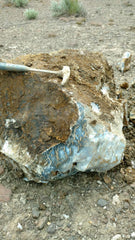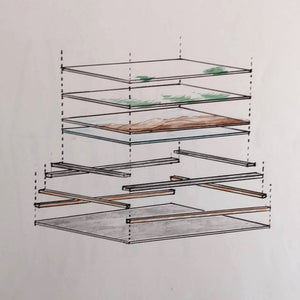News from The Gem Shop
Regency Rose Plume Agate
The Beverly Marie TGS Claim at Graveyard Point hosts two variations of plume agate. As mentioned in the recent newsletters, the north end contains the Classic Graveyard Point Plume Agate. The south end contains the Regency Rose Plume Agate. The discovery of the red plumes in some of the Regency Rose Plume Agate was discussed in last week's newsletter. It is more normal for Regency Rose Plume Agate to display combinations of white, orange, yellow, and pink plumes. Even the pink plumes are a rarity.
How the agate formed on the south side is different from the north side. The Classic Graveyard formed in the cracks of the basalt, thus creating more straight veins of agate. The Regency Rose formed in a basalt valley, which no one knows how deep it is. The veins of agate are much more jagged or triangular shaped.
Regency Rose Plume Agate is available in rough form, specimens, and cabochons. Discover this beautiful agate today!
Regency Rose Plume Agate Rough Rock
Specimens
Cabochons
Regency Rose Plume Agate - Red
Gene and his crew made a very interesting discovery while mining the south end of the Beverly Marie TGS Claim this spring. The north end of the claim is known for producing the Classic Graveyard Plume Agate, which normally contains blue, yellow, and tan plumes. Many times it has black looking marcasite inclusions. This agate was featured in last week's newsletter.
The south end of the claim contains the area where the material known as Regency Rose Plume Agate comes from. The Regency Rose name was given to the rock from this area by Bill Tallman in the 1980's, and it was known for the variety of colored plumes possible in the rock. White, orange, yellow, and pink plumes are all possible in any combination. This year Gene found some veins that contained unique red plumes. These red plumes seem to occur sporadically on one side or a corner of a vein. A limited amount of this material is now available. This special material, which has been graded as the "red" material, has a high potential to contain red plumes. The red plumes may occur just a little on the edge or it may appear more prominently throughout. Great material for slabs, cabbing, or specimens.
Regency Rose Plume Agate - Red, Rough Rock


Graveyard Point Mining Operation 2017
The agate from our spring mining operation at Graveyard Point has arrived in Cedarburg! The material from the north end of the claim is called Classic Graveyard Point Plume Agate. The agate normally displays bold dark brown and tan plumes in a translucent blue agate, but variations in color are possible. This agate is available in a variety of sizes up to 100 lbs., and some pieces have Angelwing Chalcedony tops. Mining pictures with a detailed description of the operation are available on our website.
Graveyard Point Mining Operation Update
Gene and his crew are having a great adventure in Oregon mining Graveyard Point Plume Agate. They have unearthed a large vein of agate, which has been producing some great material. You can see from the one picture how deep they have to go to get some of this agate. The plume agate has been displaying beautiful yellow, red, and orange plumes. They have had plenty of company as the Boise Rock Club and others have come out to check out the activity and pick up some agate. Gene will be wrapping up digging this weekend, but anyone is welcome to go out to the claim, with the proper permission forms( available below in the May 3rd blog post). A full mining report and new material will be available in late June. Keep an eye on the website and Facebook for announcements. In the meantime check out some of the Graveyard Point Plume Agate that you can get now on our website.
Graveyard Point Plume Agate rough rock
Graveyard Point Specimens
Graveyard Point Cabochons





Graveyard Point Mining Operation
Our very own Indiana Jones, Gene Mueller, is headed back to Oregon to mine the beautiful Graveyard Point Plume Agate. The Beverly Marie claim is located about 7 miles from Homedale, Idaho on the eastern edge of Oregon. Gene and his fellow miners will be out there from May 16th - 28th. Anyone is welcome to come out to the claim and collect agate on the claim while they are out there for $0.50 /lb. Gene cannot wait to get out there and start digging, and he welcomes your visit. Please be advised that the mining operation is under time restraints, thus there is not much time for visitation with the miners. A permission form must be filled out for each individual collecting on the claim. Please also read the "Terms & Conditions Form", which also has directions to the claim. A map of the area is also below.Permission Form
Terms & Conditions
Map of the Graveyard Point area
Zodiac Stones
Ever wonder what the stars say about you? Humans, for centuries have looked to the heavens for guidance, direction, and answeres to lifes most complicated questions. The Gem Shop is proud to introduce our latest product, Zodiac Stones. Each zodiac sign has specific stones to help guide people under these zodiac signs. The Zodiac Stones comes with three stones in a black pouch, picked specifically for that sign, with an informational card. On the back of the each card tells a little about each sign, and how the stones can offer direction or fun inspirations. Find your perfect stones for your sign, and these make great fun little gifts for anyone!thegemshop.com/collections/metaphysical
Fairy Stones
Fairy Stones are clay concretions comprised of calcium carbonate, which were formed by the glaciers. They are only found in Northern Quebec, Canada. The Fairy Stone received its name from the Algonquin Indian Tribe, who carried them for good luck. They would offer a Fairy Stone to their loved ones before leaving home on fishing or hunting trips. The stones were believed to offer protection against bad spirits. Larger Fairy Stones would be placed in the home to bring good health and prosperity to the occupants of the premises. The Gem Shop has limited amount of these ancient stones. Give one to your loved one or place in your home:
thegemshop.com/collections/fossils-minerals-1/fairy-stone
Grape Agate
A new type of chalcedony has entered the market recently, which is called Grape Agate. It is properly named purple botryoidal chalcedony that looks like a bunch of grapes. Grape Agate comes from Sulawesi, Indonesia and was discovered many years ago. It wasn't until about a year ago that the Indonesian Government allowed for the material to be exported. The Gem Shop has a limited number of these unique specimens available on our website. These beautiful pieces are a great conversation piece and addition to any rockhound's collection. Discover this new agate:thegemshop.com/collections/specimens-2/grape-agate
Ramshorn Plume Agate Pt. 2
First of all I would like to say that my friend Jake is the best agate tracker, prospector, and miner I know. He is responsible for producing major portions of the Bruneau, Morrisonite, and Rocky Butte Jasper in the market. Many of the Jaspers in Hans Gamma’s book “Picture Jaspers from the Northwest” were named by him.
Ramshorn Mountain curves around a large basin draining to the South. There are 20 or so small canyons that drain into this basin. There are 8 or so canyons on the east side of the mountain and another 20 or so canyons on the west side. The north part of the mountain is basically inaccessible except by horse, and takes more than one day's time.
When Jake and I started looking for the deposit we considered all these things and decided to systematically inspect the canyons in the basin first. It was unlikely that the deposit was on the north or northwest side of the mountain considering that an eight-year-old boy was there. Not impossible just improbable. The only access we knew of at the time was from a road that crosses the creek draining from the basin located about 5 miles north of Horse Creek Campground. It was a good 2 mile hike from the road to the bottom edge of the basin. We inspected two canyons each day we were in the area together. Jake would go up one canyon, I would go up the next, and we would meet on the ridge in the middle and compare notes. We found agate casts and other things but not the plume agate. Jake had more time to look for the agate than I did so he inspected many of the canyons by himself.
After 4 years we gave up on the basin and started considering the south and southwest side of the mountain. We discovered another very bad four wheel drive road going up the slope on the southwest corner of the mountain. This road could be driven only when the weather was dry and was a challenge for any four wheel drive vehicle. The road ended much higher on the mountain next to a beautiful mountain lake. Jake spent considerable time up here driving his four-wheeler from Horse Creek Campground to the lake and then hiking from there. He found some wonderful casts, some with plumes, in the second and third Canyons on the West Side of the Mountain.
Six years after we started looking for the plume agate Jake decided to stay in the area a little longer (the Wiggins Fork area is only accessible in July and August). In early September he was up high on the west side of the mountain when a sudden snowstorm hit. It is dangerous to be on the mountain at ten to eleven thousand feet elevation in either rain or snow. He decided to get down off the mountain as fast as possible and took several shortcuts coming off the cliffs and much to his surprise walked right over the deposit. The deposit was less that 50 yards from the trail on the way out. In fact both of us had walked by the deposit several times in the previous several years.
One year later Jake and I looked over the deposit and made plans on how to dig the agate. The vein extends straight down into the slope of the steep hillside. As far as we can tell the van might be twenty yards long. Float agate extends down the ravine for a long ways. The following was considered: 1. Because of the difficulty in getting to the deposit only 3 to 4 hours of work is possible in a one day trip to the area; 2. The deposit is small and digging straight down into the hill will only produce a small amount of rock; 3. The agate is good enough that every effort should be made to get all the agate possible and not miss any in the process.
We decided to carefully dig the float from the drainage below all the way up the hill to the vein. Jake and I started digging a 10 foot wide section from the ravine directly below the center of the vein. We started finding agates right away. For years we have been working our way up the hill in the same 10-foot span on the hillside finding all the agate that has been eroded from the vein above for centuries. This process took great discipline especially on Jake's part. Spending so much time tracking down a deposit, finding it, and then not working the vein was very hard. Any work on the vein itself will bury agate deeper that has eroded out earlier and is buried below.
We have approached the production of this material in a very disciplined way. In the years Jake and I dug here, I estimate that we have produced a total of about 500 pounds of agate. I am confident that the float in the hillside 10 feet to the left and 10 feet to the right of where we dug will also produce a lot of agate. I am hesitant to define in more detail the exact location of the deposit although with the above information it should not be that hard to find. If by chance the reader of this article finds the deposit I would only ask that you follow our lead in the digging of the rock.




